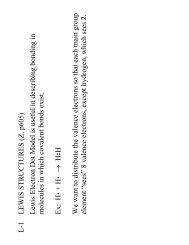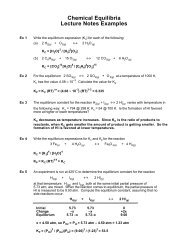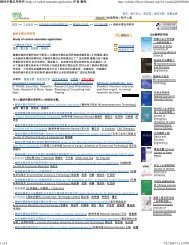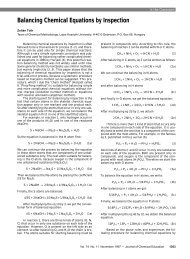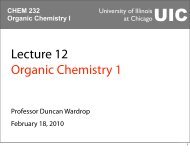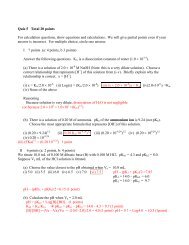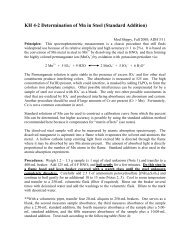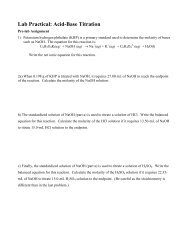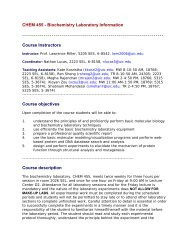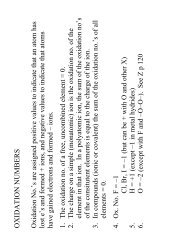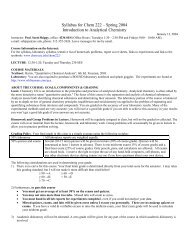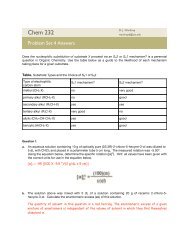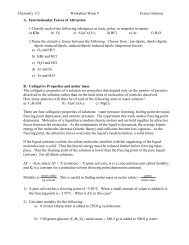Extending the limits of the selective 1D NOESY experiment with an ...
Extending the limits of the selective 1D NOESY experiment with an ...
Extending the limits of the selective 1D NOESY experiment with an ...
You also want an ePaper? Increase the reach of your titles
YUMPU automatically turns print PDFs into web optimized ePapers that Google loves.
204 Communication / Journal <strong>of</strong> Magnetic Reson<strong>an</strong>ce 171 (2004) 201–206system, provided that it is sufficiently well-resolved from<strong>the</strong> rest <strong>of</strong> <strong>the</strong> peaks. In practice, <strong>the</strong> isotropic mixingperiod is optimized so as to maximize coherence tr<strong>an</strong>sferto <strong>the</strong> target spin for <strong>the</strong> <strong>NOESY</strong> mixing period.The <strong>1D</strong> 1 H spectrum <strong>of</strong> lasalocid used in this study isshown in Fig. 2 along <strong>with</strong> its molecular structure <strong>an</strong>d1 H chemical shift assignments. The <strong>1D</strong> 1 H spectrumshows subst<strong>an</strong>tial overlap, <strong>with</strong> only a small number<strong>of</strong> well-resolved peaks in <strong>the</strong> region d > 2.4 ppm. Todemonstrate <strong>the</strong> efficiency <strong>of</strong> <strong>the</strong> new ZQF, Fig. 3 compares<strong>the</strong> <strong>selective</strong> <strong>1D</strong> TOCSY spectra <strong>of</strong> proton H 14 obtainedusing <strong>the</strong> pulse sequence <strong>of</strong> Fig. 1B, <strong>with</strong> <strong>an</strong>dFig. 3. Selective <strong>1D</strong> TOCSY spectra <strong>of</strong> lasalocid-{H 14 } obtained <strong>with</strong><strong>the</strong> pulse sequence <strong>of</strong> Fig. 1B, <strong>with</strong> (lower p<strong>an</strong>el) <strong>an</strong>d <strong>with</strong>out (lowerp<strong>an</strong>el) <strong>the</strong> ZQFs in place. A 20 ms Gaussi<strong>an</strong> 180° pulse was used in <strong>the</strong>DPFGSE for <strong>the</strong> <strong>selective</strong> excitation <strong>of</strong> H 14 . The isotropic mixingperiod was 25 ms using <strong>the</strong> DIPSI-2 sequence [30] <strong>an</strong>d a 6.25 kHz B 1field, which generated optimal magnetization tr<strong>an</strong>sfer to H 15 . When<strong>the</strong> ZQFs are omitted (upper p<strong>an</strong>el), <strong>the</strong> spectrum shows signific<strong>an</strong>t<strong>an</strong>ti-phase distortions due to ZQ interference. These distortions areessentially absent when <strong>the</strong> ZQFs are included (lower p<strong>an</strong>el). A 30 or50 ms const<strong>an</strong>t-adiabaticity WURST inversion pulse [24] <strong>with</strong> ab<strong>an</strong>dwidth <strong>of</strong> 20 or 30kHz was used in each <strong>of</strong> <strong>the</strong> ZQFs, respectively.The gradients were optimized accordingly as described by Thrippleton<strong>an</strong>d Keeler [22].<strong>with</strong>out <strong>the</strong> ZQFs. In <strong>the</strong> case where no ZQ filtrationis applied (upper p<strong>an</strong>el), <strong>the</strong> <strong>an</strong>ti-phase contributionsby ZQC to <strong>the</strong> multiplet patterns are evident. These<strong>an</strong>ti-phase distortions are largely absent when two ZQFs<strong>with</strong> appropriately adjusted durations <strong>an</strong>d gradientstrengths are applied (lower p<strong>an</strong>el). The apparentlyhigher resolution exhibited by H 15 in <strong>the</strong> absence <strong>of</strong>ZQ filtration (upper p<strong>an</strong>el) is only a deception attributableto <strong>an</strong>ti-phase components introduced by ZQ interference,as c<strong>an</strong> be confirmed by comparison <strong>with</strong> <strong>the</strong> <strong>1D</strong>1 H spectrum.The spin system consisting <strong>of</strong> protons H 14 ,H 15 ,H 16 ,H 17a , <strong>an</strong>d H 17b provides <strong>an</strong> excellent example for <strong>the</strong>STEP–<strong>NOESY</strong> <strong>experiment</strong> shown in Fig. 1C. In <strong>the</strong><strong>1D</strong> 1 H spectrum (Fig. 2), <strong>with</strong> <strong>the</strong> only exception <strong>of</strong>H 14 , all <strong>of</strong> <strong>the</strong>se peaks show at least some degree <strong>of</strong> overlap,rendering <strong>the</strong>m unsuitable for direct <strong>selective</strong> excitation.With <strong>the</strong> additional spectral editing step providedby <strong>the</strong> STEP function, it is now straightforward to <strong>selective</strong>lyexcite each one <strong>of</strong> <strong>the</strong> reson<strong>an</strong>ces <strong>an</strong>d observe itsNOE correlations.The doubly <strong>selective</strong> <strong>1D</strong> STEP–<strong>NOESY</strong> spectrum <strong>of</strong>{H 15 {H 14 }} obtained <strong>with</strong> <strong>the</strong> pulse sequence <strong>of</strong> Fig. 1Cis shown in Fig. 4A, where <strong>the</strong> shorth<strong>an</strong>d notation{H b {H a }} denotes H a as <strong>the</strong> target spin for <strong>the</strong> STEPfunction, <strong>an</strong>d H b for <strong>the</strong> NOE mixing period. All <strong>of</strong><strong>the</strong> NOE correlations c<strong>an</strong> be assigned in a straightforwardm<strong>an</strong>ner. However, <strong>the</strong>re still exist signific<strong>an</strong>t distortionsto <strong>the</strong> multiplets <strong>of</strong> those spins scalar coupledto H 15 . This is better exemplified in <strong>the</strong> NOE buildup<strong>of</strong> H 17a , shown in Fig. 4B. The <strong>an</strong>ti-phase distortionsare evident for shorter mixing times, while for intermediateto longer NOE mixing times, such distortions areseemingly absent. However, <strong>the</strong> H 17a peak appears tobe a doublet, while all o<strong>the</strong>r available evidences (e.g.,its coupling to both H 17b <strong>an</strong>d H 15 ) suggest that it shouldbe a doublet <strong>of</strong> a doublet.As pointed out by Shaka <strong>an</strong>d co-workers [26,27],such distortions are not <strong>the</strong> result <strong>of</strong> ZQC leakagethrough <strong>the</strong> ZQFs. Instead, <strong>the</strong>ir origin is a phenomenonknown as spin-state mixing, which is encounteredin strongly scalar coupled spin systems. Even though<strong>the</strong>se distortions are generally ra<strong>the</strong>r small, <strong>the</strong>y pose asignific<strong>an</strong>t problem in <strong>the</strong> NOE <strong>experiment</strong>, since <strong>the</strong>signals <strong>of</strong> interests are usually very weak. These authorsfur<strong>the</strong>r demonstrated that, by subtracting a referencespectrum <strong>with</strong> ‘‘zero’’ mixing time, <strong>the</strong>se distortionsc<strong>an</strong> be largely removed. This results in a double differencespectrum. The same principle c<strong>an</strong> be applied to<strong>the</strong> STEP–<strong>NOESY</strong> <strong>experiment</strong>. Fig. 4C shows <strong>the</strong> doubledifference STEP–<strong>NOESY</strong> spectrum <strong>of</strong> {H 15 {H 14 }}.Note that <strong>the</strong>re is a slight reduction in <strong>the</strong> signal-tonoisecompared to <strong>the</strong> single difference spectrum <strong>of</strong>Fig. 4A. However, <strong>the</strong> correct multiplet patterns arenow restored for all <strong>of</strong> <strong>the</strong> spins coupled to H 15 . Forcomparison, <strong>the</strong> distortion-free NOE buildup <strong>of</strong> H 17a
Communication / Journal <strong>of</strong> Magnetic Reson<strong>an</strong>ce 171 (2004) 201–206 205Fig. 4. Comparison <strong>of</strong> <strong>the</strong> single (A <strong>an</strong>d B) <strong>an</strong>d double difference (C <strong>an</strong>d D) <strong>1D</strong> STEP–<strong>NOESY</strong> spectra <strong>of</strong> lasalocid-{H 15 {H 14 }} recorded <strong>with</strong> <strong>the</strong>pulse sequence <strong>of</strong> Fig. 1C. Each FID was acquired <strong>with</strong> 1024 tr<strong>an</strong>sients. Selective excitation <strong>of</strong> both H 14 <strong>an</strong>d H 15 was achieved <strong>with</strong> <strong>the</strong> DPFGSEsequence using a 20 ms Gaussi<strong>an</strong> 180° pulse. The isotropic mixing period for <strong>the</strong> STEP function was 25 ms, which was optimized using <strong>the</strong> pulsesequence <strong>of</strong> Fig. 1B to yield maximum magnetization tr<strong>an</strong>sfer to H 15 . The two ZQFs in <strong>the</strong> STEP function were identical to those described in Fig. 3.The ZQF at <strong>the</strong> end <strong>of</strong> <strong>the</strong> NOE mixing time used a 50 ms const<strong>an</strong>t-adiabaticity WURST sweep <strong>with</strong> a 30 kHz b<strong>an</strong>dwidth. Two 1.5 ms hyperbolicsec<strong>an</strong>t 180° pulses were used for <strong>the</strong> ‘‘nulling’’ pulses. (A) The single difference <strong>1D</strong> STEP–<strong>NOESY</strong> spectrum <strong>of</strong> {H 15 {H 14 }} using a NOE mixing time<strong>of</strong> 500 ms. Note <strong>the</strong> <strong>an</strong>ti-phase distortions for <strong>the</strong> multiplets <strong>of</strong> H 14 ,H 16 ,H 17a , <strong>an</strong>d H 17b . (B) The NOE buildup <strong>of</strong> H 17a {H 15 {H 14 }} obtained from<strong>the</strong> single difference spectra. The NOE mixing time was increased systematically from 100 to 1000 ms in 100 ms steps. The target intensity in eachspectrum was normalized, <strong>the</strong>refore <strong>the</strong> differences in <strong>the</strong> signal-to-noise. (C) The double difference <strong>1D</strong> STEP–<strong>NOESY</strong> spectrum <strong>of</strong> {H 15 {H 14 }} usinga NOE mixing time <strong>of</strong> 500 ms. It was obtained by taking <strong>the</strong> spectral difference between <strong>the</strong> single difference spectrum <strong>of</strong> (A) <strong>an</strong>d <strong>the</strong> nominally‘‘zero’’ mixing time spectrum, which is recorded by setting <strong>the</strong> NOE mixing delays to zero, but leaving <strong>the</strong> ZQF, <strong>the</strong> two nulling 180° pulses, <strong>an</strong>d <strong>the</strong>associated gradient pulses intact. (D) The distortion-free NOE buildup <strong>of</strong> H 17a {H 15 {H 14 }} obtained from <strong>the</strong> double difference spectra. The NOEmixing times were <strong>the</strong> same as in (B).obtained using <strong>the</strong> double difference methodology isshown in Fig. 4D.3. ConclusionsWe have demonstrated <strong>the</strong> application <strong>of</strong> <strong>an</strong> improved<strong>selective</strong> TOCSY edited preparation functionto <strong>the</strong> doubly <strong>selective</strong> <strong>1D</strong> TOCSY–<strong>NOESY</strong> <strong>experiment</strong>.The incorporation <strong>of</strong> a novel ZQF into <strong>the</strong> STEPfunction as well as <strong>the</strong> NOE mixing period permitshighly efficient ZQ suppression <strong>with</strong>in a single sc<strong>an</strong>.Additional <strong>an</strong>ti-phase distortions due to spin state mixingc<strong>an</strong> be conveniently removed using <strong>the</strong> double differencemethodology introduced by Shaka et al. [27]. Thecombined use <strong>of</strong> <strong>the</strong>se methods allows one to obtainvery high quality NOE spectra for <strong>the</strong> reliable identification<strong>of</strong> weak NOE enh<strong>an</strong>cements, which would o<strong>the</strong>rwisebe hindered by <strong>the</strong> presence <strong>of</strong> <strong>an</strong>ti-phasecomponents due to ZQ interference. Moreover, <strong>the</strong>STEP function described here affords a general strategyfor spectral simplification <strong>an</strong>d c<strong>an</strong> be applied to a wider<strong>an</strong>ge <strong>of</strong> <strong>experiment</strong>s. One such example is to incorporate<strong>the</strong> STEP function into <strong>the</strong> 2D DOSY <strong>experiment</strong>[31] as a spectral editing period, which would greatlysimplify <strong>the</strong> <strong>an</strong>alysis <strong>of</strong> complex mixtures <strong>of</strong> drugmetabolites. A detailed description <strong>of</strong> applications alongthis line will be presented elsewhere.References[1] J. Jeener, B.H. Meier, P. Bachm<strong>an</strong>n, R.R. Ernst, Investigation <strong>of</strong>exch<strong>an</strong>ge processes by two-dimensional NMR spectroscopy, J.Chem. Phys. 71 (1979) 4546–4553.[2] P. Adell, T. Parella, F. S<strong>an</strong>chez-Ferr<strong>an</strong>do, A. Virgili, Cle<strong>an</strong><strong>selective</strong> spin-locking spectra using pulsed field gradients, J.Magn. Reson. B 108 (1995) 77–80.[3] C. Dalvit, New one-dimensional <strong>selective</strong> NMR <strong>experiment</strong>s inaqueous solutions recorded <strong>with</strong> pulsed field gradients, J. Magn.Reson. A 113 (1995) 120–123.[4] H. Kessler, H. Oschkinat, C. Griesinger, W. Bermel, Tr<strong>an</strong>sformation<strong>of</strong> homonuclear two-dimensional NMR techniques intoone-dimensional techniques using Gaussi<strong>an</strong> pulses, J. Magn.Reson. 70 (1986) 106–133.[5] H. Kessler, U. Anders, G. Gemmecker, S. Steuernagel, Improvement<strong>of</strong> NMR <strong>experiment</strong>s by employing semi<strong>selective</strong> half-Gaussi<strong>an</strong>-shaped pulses, J. Magn. Reson. 85 (1989) 1–14.
206 Communication / Journal <strong>of</strong> Magnetic Reson<strong>an</strong>ce 171 (2004) 201–206[6] K. Stott, J. Stonehouse, J. Keeler, T.-L. Hw<strong>an</strong>g, A.J. Shaka,Excitation sculpting in high-resolution nuclear magnetic reson<strong>an</strong>cespectroscopy: application to <strong>selective</strong> NOE <strong>experiment</strong>s, J.Am. Chem. Soc. 117 (1995) 4199–4200.[7] K. Stott, J. Keeler, Q.N. V<strong>an</strong>, A.J. Shaka, One-dimensional NOE<strong>experiment</strong>s using pulsed field gradients, J. Magn. Reson. 125(1997) 302–324.[8] J. Stonehouse, P. Adell, J. Keeler, A.J. Shaka, Ultrahigh-qualityNOE spectra, J. Am. Chem. Soc. 116 (1994) 6037–6038.[9] R.E. Hurd, Gradient-enh<strong>an</strong>ced spectroscopy, J. Magn. Reson. 87(1990) 422–428.[10] A.A. Maudsley, A. Wokaun, R.R. Ernst, Coherence tr<strong>an</strong>sferechoes, Chem. Phys. Lett. 55 (1978) 9–14.[11] T.-L. Hw<strong>an</strong>g, A.J. Shaka, Water suppression that works. Excitationsculpting using arbitrary waveforms <strong>an</strong>d pulsed fieldgradients, J. Magn. Reson. A 112 (1995) 275–279.[12] L. Braunschweiler, R.R. Ernst, Coherence tr<strong>an</strong>sfer by isotropicmixing: application to proton correlation spectroscopy, J. Magn.Reson. 53 (1983) 521–528.[13] P. Adell, T. Parella, F. S<strong>an</strong>chez-Ferr<strong>an</strong>do, A. Virgili, Gradientselection in pseudo-3D <strong>experiment</strong>s, J. Magn. Reson. A 113 (1995)124–127.[14] M.J. Gradwell, H. Kogelberg, T.A. Frenkiel, Applying excitationsculpting to construct singly <strong>an</strong>d doubly <strong>selective</strong> <strong>1D</strong> NMR<strong>experiment</strong>s, J. Magn. Reson. 124 (1997) 267–270.[15] D. Uhrin, P.N. Barlow, Gradient-enh<strong>an</strong>ced one-dimensionalproton chemical-shift correlation <strong>with</strong> full sensitivity, J. Magn.Reson. 126 (1997) 248–255.[16] L. Poppe, H. v<strong>an</strong> Halbeek, NOE measurements on carbohydratesin aqueous solution by double-<strong>selective</strong> pseudo-3D TOCSY-ROESY <strong>an</strong>d TOCSY–<strong>NOESY</strong>. Application to Gentiobiose, J.Magn. Reson. 96 (1992) 185–190.[17] S. Macura, Y. Hu<strong>an</strong>g, D. Suter, R.R. Ernst, Two-dimensionalchemical exch<strong>an</strong>ge <strong>an</strong>d cross-relaxation spectroscopy <strong>of</strong> couplednuclear spins, J. Magn. Reson. 43 (1981) 259–281.[18] S. Macura, K. Wuthrich, R.R. Ernst, Separation <strong>an</strong>d suppression<strong>of</strong> coherent tr<strong>an</strong>sfer effects in two-dimensional NOE <strong>an</strong>d chemicalexch<strong>an</strong>ge spectroscopy, J. Magn. Reson. 46 (1982) 269–282.[19] M. R<strong>an</strong>ce, G. Bodenhausen, G. Wagner, K. Wuthrich, R.R.Ernst, A systematic approach to <strong>the</strong> suppression <strong>of</strong> J cross peaksin 2D exch<strong>an</strong>ge <strong>an</strong>d 2D NOE spectroscopy, J. Magn. Reson. 62(1985) 497–510.[20] A.L. Davis, G. Estcourt, J. Keeler, E.D. Laue, J.J. Titm<strong>an</strong>,Improvement <strong>of</strong> z filters <strong>an</strong>d purging pulses by <strong>the</strong> use <strong>of</strong> zeroqu<strong>an</strong>tumdephasing in inhomogeneous B 1 or B 0 fields, J. Magn.Reson. A 105 (1993) 167–183.[21] G. Estcourt, A.L. Davis, J. Keeler, Suppression <strong>of</strong> zero-qu<strong>an</strong>tuminterference in two-dimensional z-COSY spectra, J. Magn. Reson.96 (1992) 191–198.[22] M.J. Thrippleton, J. Keeler, Elimination <strong>of</strong> zero-qu<strong>an</strong>tum interferencein two-dimensional NMR spectra, Angew. Chem. Int. Ed.Engl. 42 (2003) 3938–3941.[23] K.E. C<strong>an</strong>o, M.J. Thrippleton, J. Keeler, A.J. Shaka, Cascaded z-filters for efficient single-sc<strong>an</strong> suppression <strong>of</strong> zero-qu<strong>an</strong>tumcoherence, J. Magn. Reson. 167 (2004) 291–297.[24] E. Kupce, R. Freem<strong>an</strong>, Adiabatic pulses for wideb<strong>an</strong>d inversion<strong>an</strong>d broadb<strong>an</strong>d decoupling, J. Magn. Reson. A 115 (1995) 273–276.[25] G. Xu, J.S. Ev<strong>an</strong>s, The application <strong>of</strong> excitation sculpting in <strong>the</strong>construction <strong>of</strong> <strong>selective</strong> one-dimensional homonuclear coherencetr<strong>an</strong>sfer<strong>experiment</strong>s, J. Magn. Reson. B 111 (1996) 183–185.[26] A.J. Shaka, Europe<strong>an</strong> Small Molecule Meeting, MSD TerlingsPark, UK, 2001.[27] K.E. C<strong>an</strong>o, M.J. Thrippleton, J. Keeler, A.J. Shaka, Improvedtr<strong>an</strong>sient NOE buildups in coupled spin systems, in: 45thExperimental NMR Conference, Pacific Grove, USA, 2004.[28] E. Kupce, R. Freem<strong>an</strong>, Techniques for multisite excitation, J.Magn. Reson. A 105 (1993) 234–238.[29] G. Bodenhausen, R. Freem<strong>an</strong>, D.L. Turner, Suppression <strong>of</strong>artifacts in two-dimensional J spectroscopy, J. Magn. Reson. 27(1977).[30] S.P. Rucker, A.J. Shaka, Broadb<strong>an</strong>d homonuclear cross polarizationin 2D NMR using DIPSI-2, Mol. Phys. 68 (1989) 509–517.[31] K.F. Morris, C.S. Johnson Jr., Diffusion-ordered two dimensionalnuclear magnetic reson<strong>an</strong>ce spectroscopy, J. Am. Chem. Soc. 114(1992) 3139–3141.



